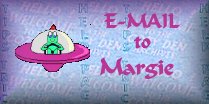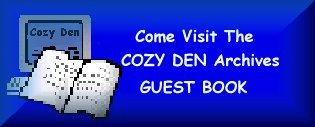Cozy Den Archives
WIN TIP OF THE DAYThese are the WinTips for the weeks of
May 31 through June 11, 1999!*****************************************
* * T I P O F T H E D A Y May 31, 1999 - Coopy or move to floppy * *
* When you use Win9x's Send To feature (right-click on the item, then select Send To from the Context menu) to place something on a floppy disk or on a drive other than your C: drive, the file is copied. To move it, hold down the Shift key while clicking on the Send To item.*
******************************************
* * T I P O F T H E D A Y June 1, 1999 - Windows Keyboard tips * *
* You can move or resize open Windows applications by using only your keyboard. First, press Alt+Spacebar to bring up a menu. Press S, then use the arrow keys to resize the window. Press M and move the window using the arrow keys. Press Enter to keep the window change or Esc to return the window to its previous state.*
******************************************
* * T I P O F T H E D A Y June 2, 1999 * *
Seems to be missing...lost in space..uh cyberspace!
******************************************
* * T I P O F T H E D A Y June 3, 1999 - File not found Error * *
* It's not uncommon in Windows to encounter a "File Not Found" error while booting up. The message indicates that a particular file-usually a DLL or VXD-is missing. Chances are, the file was improperly removed when you uninstalled an application. The file may be gone, but one or more lines in your System Registry or SYSTEM.INI could still be trying to load it. To fix the problem, reboot and note the exact name of the errant file. From the Windows taskbar, select Start/Find/Files and Folders to search for the missing file. If you find it, copy it to your WINDOWS or WINDOWS\SYSTEM folder. If you think you might have moved or renamed a program folder, make a new folder with the old name, and copy the offending file there. Reboot and see if the message goes away. *
******************************************
* * T I P O F T H E D A Y June 4, 1999 - locate lost program files* *
** If you don't find the file, you must find a reference in your Registry or SYSTEM.INI to a program that no longer exists on your system. Use the Registry Editor's search function to find the filename, then use Notepad to open and search SYSTEM.INI for the same file. When you find any references to the file, carefully note where it is and the exact settings in case you have to reinstate it, then delete the references. (Back up your Registry before making any changes.) Also check the WINDOWS\STARTUP folder for any shortcuts that call the file, and delete them.*
******************************************
* * T I P O F T H E D A Y June 7, 1999 * * Install tips* *
* You'll increase your chances of getting out of virtually any computer problem if you follow this rule of thumb: Never install a program unless you own it, and have the executable setup file and installation CD or installation floppy disk handy. The same rule goes for programs you download from the Internet: Always save the installer files. Create a folder called C:\Setup, C:\Downloads or C:\Installers and store the setup files in subfolders named for each program and version number. Even better, store them on a second hard drive or partition. You should also copy the Favorite shortcut to the program's Web site to the program's folder. If there's a program serial number or license file, store that too. If you ever have to reinstall your applications, you'll be prepared.*
******************************************
* * T I P O F T H E D A Y June 8, 1999 * *
Seems to missing in action...lost in the ozone...gone and forgotten!
******************************************
* * T I P O F T H E D A Y June 9, 1999* * Launch Control I
* Some programs tell Windows to launch them at start-up by placing a shortcut in the StartUp folder. To remove start-up programs, right-click on the Start button and select Open. Double-click on the Programs folder, then the StartUp folder. Delete shortcuts to programs you don't want to run at start-up. Or just drag the shortcut out to the Desktop to temporarily remove it from the StartUp folder. You can drag it back later or delete it. *
******************************************
* * T I P O F T H E D A Y June 10, 1999 * * Defrag Virtual Memory*
* Although the Disk Defragmenter utility speeds up file access, it doesn't defrag your swap file, which is t he file Windows uses as virtual memory. You can get additional performance gains by disabling your swap file, defragging your disk, then re-enabling the swap file. The new swap file will be effectively defragged and therefore faster. To do so, right-click on My Computer and select Properties from the Context menu. Click on the Performance tab, then the Virtual Memory button. Select the "Let me specify my own virtual memory settings" radio button, then select Disable Virtual Memory. Click on OK, then OK again. After defragging your disk, follow the same procedure above, but this time select "Let Windows manage my virtual memory setting."
******************************************
* * T I P O F T H E D A Y June 11, 1999 * * *Explorer Function Key - F4*
* If you're a killer keyboard commando-we're guessing that you are-you should know the function keys that let you rip through Windows Explorer. The F4 function key opens the Address drop-down menu and highlights it so you can quickly use your arrow keys to navigate local or network drives, plus My Computer and Desktop folders. .
******************************************



Glad you came to visit!
Please SIGN the Cozy Den Archives GUESTBOOK!
